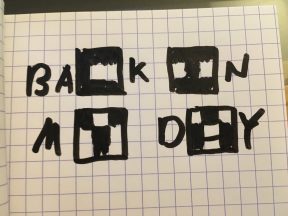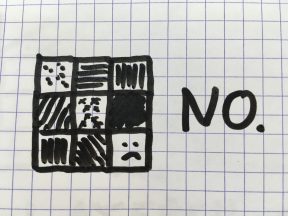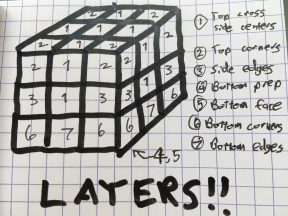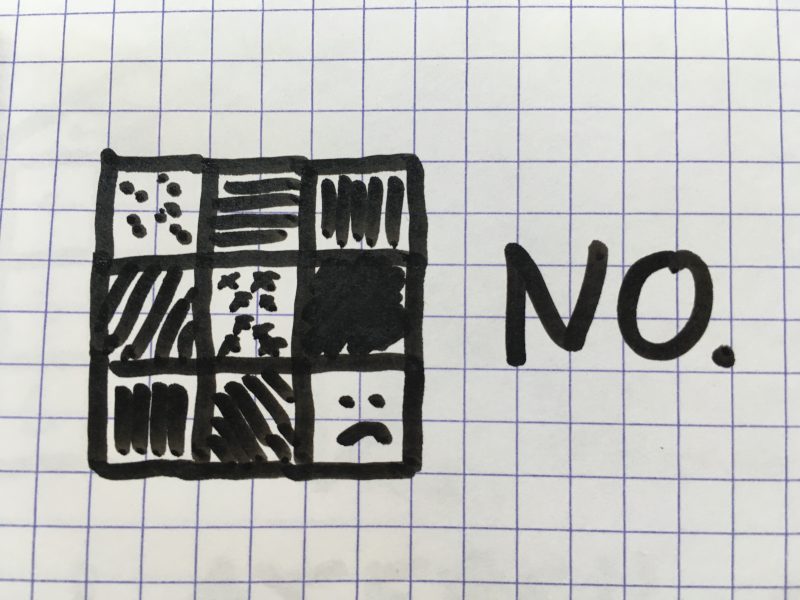I think everyone’s had a Rubik’s cube at some point or otherwise been exposed to this hunk of plastic that starts with eight sides, distinctly colored and orderly. More likely it’s found in some state of disarray with maybe one side with all the colors right but every other side is a random mishmash. Maybe we even knew someone who claims to have solved one. Well, it turns out I am one of those people, and I can do it relatively quickly… and also relatively slowly.

History Lesson
My exposure to the Rubik’s cube was seeing my Dad try to solve it. I say try because I don’t think I ever saw him do it, but I like to think he could. Mostly because I saw a book about how to solve it. Yes, a book! It might have been this one. This was back in the 1980s, so where else does someone go to learn something? I remember specifically it was a black and white book. I know, right? It’s a book about solving a puzzle cube with colors on it… how could you not spend the extra cash for a color page or two? It used different shading or cross-hatching patterns to distinguish sides. I remember picking it up and trying to read it and getting fantastically frustrated… probably because at age 7 or 8 I wasn’t quite grasping the non-linear decision trees involved. Also the black and white pictures. Have I complained about that yet?
I put the cube down. OK, maybe I took the stickers off and put them back to solve it. Still, it probably got tucked into a shelf along with that book for quite a few years. Then I got a party favor!
Julie’s grandmother is a sudoku addict. She probably has a few puzzle magazines tucked away for emergencies in her handbag. At a birthday party not that long ago she gave away very tiny (and very pastel colored) puzzle cubes as a reminder to keep the mind sharp. Having a reputation as a good troubleshooter and helpful expert I had a few family members look quizzically at me when I couldn’t solve it. I decided I should at least give it a try.
I found lots and lots of solution guides. People had been solving these things since they came out. Remember the black and white book? I’m sorry to say some of the websites I found were not much better. Seemed like every site led with a very confusing page with uppercase and lowercase letters or all upper case but with apostrophes or even groupings of letters and sometimes numbers.
I seemed to be falling into the middle of the solutions – I’d see a lot of algorithms for moving cubes or dealing with specific patterns but not a lot of theory about what to do from a big picture point of view. When I finally found a pretty good site with a solution that made sense I found an error!
I couldn’t believe it either. The internet was wrong! I was on maybe the second to last step and sure enough, there was a move algorithm to make all the colors on the last face match, and it just didn’t work. I tried to look for other algorithms to compare, but the method I found didn’t match up to the methods on other sites. It wasn’t just the notation (which was also different!), but the actual movements were just different. I was so close. It was too hard in my head to switch between the two notations, though, that I ended up translating them so I could have one page to look at. I was a fanatic, but I solved it!

What’s the solution?
The trick for me was breaking away from 2D. I was a whiz at 2D. I liked magic square puzzles and the “15” or “8” slider puzzles with the numbers that you have to arrange. That third dimension is a pain to a young mind. Even now it makes my brain hurt sometimes. I kept trying to solve them face by face and I might get one or two faces but then get stuck in a rut — how do you solve another face without messing up the first two? I figured the solution had to involve magic moves to swap places with things without disturbing everything else. I was sorta right.
The method to solve is to do it in layers – pick one side and solve it then extend the solution layer by layer away from it. There are still some “magic” swap moves that one has to memorize but it’s a lot fewer cases when approached this methodically. It’s about 7 moves to memorize.
I think it took upwards of 10 minutes. Still much faster than my time of “never” unless you count that one time I cheated with the stickers. Still, I knew this would work. So I tried it again. And Again. And again!
I got pretty fast. I probably am inside 2 minutes with the cube, and I started to hit a wall. The layer-by-layer approach is good in that it’s very methodical.
I couldn’t get faster though, because it turns out, this is the Beginner Method.

Did You Mean To Capitalize That?
Turns out, I did. Despite my internet searching skills, I had somehow gone right over the one source I will link for cube solving. The one from rubiks.com – yep. The maker of the cube has a solution website.
I like to think maybe it didn’t exist when I was initially searching. In any case, their search-engine-optimization algorithm was less well set up.
Rubik’s lines out pretty succinctly and very clearly (with good notation and color coding and theory steps) how to solve the cube. It’s exactly what I was doing and it was so well notated and clear I just solved it a few mores times, and I definitely did well… but I didn’t get faster.
It turns out there’s an amount of overhead built into this method. There’s a lot of analysis and re-analysis that happens after every layer is solved. It’s possible to look ahead and queue moves to happen successively, so that time can be shaved down. There are two spots where a set of moves is done to permute pieces. That is, the same set of moves is done and it exchanges two or more pieces in a pattern that repeats. This is great for learning because one only has to remember one algorithm but it means one might have to do the same move a few times rather than one move.
Thus enters a bunch more memorization. To get faster it seems widely accepted to solve the first two layers (F2L in most parlance) in a single go which appears to require a lot more memorization than just the 7 moves I need for the beginner method. Instead of 7 moves I saw one site that had 41 cases, each with its own move algorithm!
Mmmm… no thanks.
My goal was to solve it, and I definitely did that. I’m quite proud of my ninety second time. It’s certainly fast enough to do at parties, and unless I really want to compete at it, that’s probably the right level of exposure to either ignite the journey of learning or decide to skip it and having another drink. I think it’s impressive to see people solving it faster– to say nothing of one-handed or blindfolded — but it’s at such another level it stops being understandable.
I really do like a lot of expertise, but I also like to relate that expertise to people. The beginner method is certainly impressive to a majority of folks, as it takes what looks like a mess and pretty quickly turns it into a nice orderly cube. It’s a nice exercise of bringing order to the universe and it’s not bad for nervous energy– in which case going faster is actually a detriment!
 © 2016 Me. All rights reserved.
© 2016 Me. All rights reserved.
Warning: Trying to access array offset on value of type null in /usr/home/web/wordpress/wp-content/themes/autofocus/inc/autofocus-template-tags.php on line 307
Warning: Trying to access array offset on value of type null in /usr/home/web/wordpress/wp-content/themes/autofocus/inc/autofocus-template-tags.php on line 310
Warning: Trying to access array offset on value of type null in /usr/home/web/wordpress/wp-content/themes/autofocus/inc/autofocus-template-tags.php on line 313